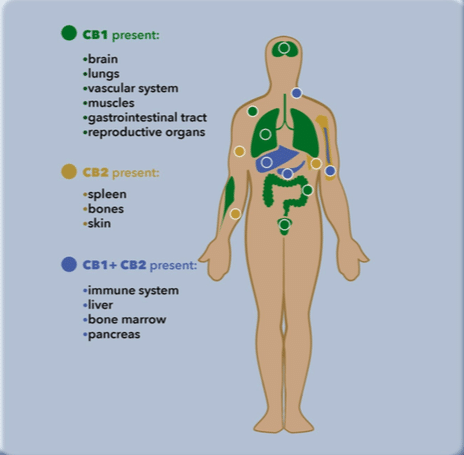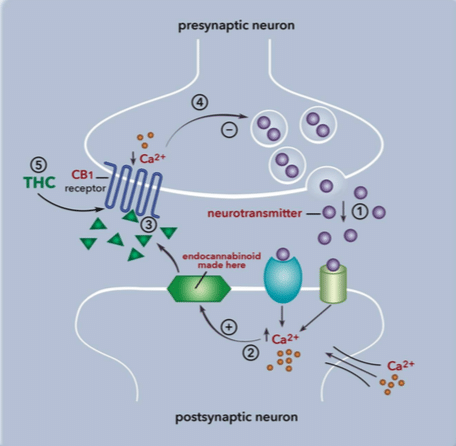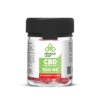Articles
CBD and the endocannabinoid system
What is the endocannabinoid system?
Each cell has many receptors, all of which are activated by special compounds specific to them – glutamate bind to glutamate receptors; serotonin to serotonin receptors; dopamine to dopamine receptors, endocannabinoids to cannabinoid receptors, and a whole lot more!
The endocannabinoid system is made up of the CB1 and CB2 receptors, which are activated by the two main endocannabinoids, anandamide and 2-AG. Anandamide binds to the CB1 receptors, while 2-AG bind to both the CB1 and CB2 receptors.
The endocannabinoid system is our body’s system of endocannabinoid receptors and the endocannabinoids that interact with them.
An easy way to understand how the endocannabinoid system works is to think of it as a lock and key mechanism. The cannabinoid receptors are the locks, and the endocannabinoids are the keys. When the endocannabinoids bind to the cannabinoid receptors, they are able to produce physiological responses necessary for keeping cells alive and healthy.
In fact, you can say that the endocannabinoid system is one of the most important systems in the body because its main function is to maintain balance and homeostasis.
Where are the cannabinoid receptors located?
The cannabinoid receptors we currently know the most about are the CB1 and CB2 receptors. In the future, researchers will likely find more cannabinoid receptors in the body.
Cannabinoid receptors are found all over the body. They are everywhere – the brain, the spinal cord, the immune system, the internal organs, the peripheral nervous system, and even on the skin! In fact, the endocannabinoid system is the most widespread receptor system[ii] in the human body.
However, the CB1 receptors are predominantly found in the central nervous system – your brain and spinal cord; the CB2 receptors are predominantly found in the immune system, specifically the white blood cells.

Locations of cannabinoid receptors
cr: Cannabis Revealed by Dr. Bonni Goldstein
Stimulating the CB1 receptors produces a myriad of effects. It regulates so many physiological processes – sleep, memory, emotional responses, mood, appetite, temperature, among others. It can even regulate the sensation of pain.
Stimulating the CB2 receptors, on the other hand, produces widespread anti-inflammatory effects since they are mostly located in the immune cells.
There is the possibility that there is a third cannabinoid receptor, but its location and how it functions haven’t been clearly defined yet.
What are endocannabinoids?
There are two main types of endocannabinoids. They are anandamide and 2-AG.
Anandamide is the most studied and activates the CB1 receptors to produce their beneficial effects. Unfortunately, anandamide is a short-order neurotransmitter. The body only produces this endocannabinoid when it needs it.
Also, anandamide doesn’t stay long in the body because it’s easily degraded by an enzyme called fatty acid amide hydrolase or FAAH. Whatever benefit we get from anandamide is short-lived because it is quickly broken down by these enzymes.
The same is true with the second endocannabinoid, 2-AG, which binds to both the CB1 and CB2 receptors. It’s also produced on demand but is quickly degraded by monoacylglycerol lipase. And just like anandamide, its actions are also short-lived.
Our endocannabinoids, although important and beneficial, can be limited by their short lifespan[iii].
What is the importance of the endocannabinoid system?
As mentioned earlier, the endocannabinoid system is a very integral system that modulates almost everything within the body.
The endocannabinoid system regulates[iv]:
- Gastrointestinal activity
- Cardiovascular activity
- Pain Perception
- Modulation of neurotransmitter release
- Maintenance of bone mass
- Protection of neurons
- Hormonal regulation
- Metabolism control
- Immune function
- Inflammatory reactions
- Inhibition of tumor cells
As you can see, your endocannabinoid system is responsible for a lot of important functions going on in your body!
The endocannabinoid system is the gatekeeper of homeostasis[v].
So how does the endocannabinoid system modulate almost everything? How does it work?
Before I tell you how the endocannabinoid system works, I’ll briefly explain to you how signals are normally transmitted by the cells. This is important because this is one of the factors that make the endocannabinoid system unique.
Our cells communicate through chemical signals. When a stimulus stimulates a cell, it will trigger the presynaptic portion of the cell to release chemicals, be it hormones, neurotransmitters, special proteins, signaling molecules, etc. Now, the chemical signal will travel in a forward direction. It will go from the presynaptic cell, cross the synapse, and bind to its specific receptor on the postsynaptic cell. And on and on the signal will go until it reaches the brain. The brain will then release chemicals that carry the command for how the body will react to the stimulus.
Now this is where the endocannabinoid system really gets interesting.
A stressor like a noxious stimulus will also trigger the endocannabinoid system to release endocannabinoids. But instead of the presynaptic cell releasing the endocannabinoids, it is the postsynaptic cell that releases the chemical.
Endocannabinoids, unlike most neurotransmitters, travel in a backward direction called retrograde signaling[vi]. The postsynaptic neuron will release endocannabinoids, and the endocannabinoids will cross the synapse to attach to the presynaptic neuron’s cannabinoid receptors.
And what happens next is beautiful.
Endocannabinoids, when they bind to their receptors, have the ability to modulate the neuron’s activity. This is how the endocannabinoid system maintains balance in the body.
Take for example a neurological disease. The result of too many excitatory neurotransmitters in the brain will cause the receptors to become overexcited and overactive. Because there is an imbalance, there will be a worsening of the disease. Case in point: stress and anxiety disorders.

Endocannabinoid and Cannabinoid Receptor Activity
cr: Cannabis Revealed by Dr. Bonni Goldstein
Now the endocannabinoids, when they’re released and attach to their receptors, can tell the neuron[vii] to stop producing or stop absorbing the excitatory neurotransmitters. The neuron will listen and “calm down,” so homeostasis and balance are once more achieved in the body.
What this means is that even when a signal has already been fired by a neuron, endocannabinoids can still influence the neuron and change its response to the stimulus because of retrograde signaling. The endocannabinoid system is a like a guard always watching over your body, ready to take action anytime there is a disturbance.
Here’s another very interesting thing about our endocannabinoid system.
Upon injury, immune cells will flock to the site of the injury and release a protein called cytokine. The cytokine will then send the signal that it needs more immune cells in the area. On and on the cytokines will recruit more immune cells. They only stop recruiting when anti-inflammatory proteins tell the immune cells to stop their cytokine production.
Now inflammation is good since it’s our natural and first-line-of-defense against irritants and pathogens. But sometimes, the inflammatory process can become overactive and worsen the medical condition, which effectively delays the healing process. In fact, there are numerous medical conditions worsened by inflammation
Now, endocannabinoids have the ability to inhibit inflammation[viii] by binding to the CB2 receptors of the cytokine-producing immune cells. When these receptors are stimulated, they produce widespread anti-inflammatory effects by causing the apoptosis (cell death) of the immune cells. With the immune cells inactivated, there will be no more production of cytokines. Inflammation is controlled and proper healing can start.
The endocannabinoid system also regulates our blood pressure[ix]. Hypertensive? The endocannabinoid system can lower your blood pressure. Hypotensive? The endocannabinoid system can increase your blood pressure. Again, balance is promoted by the endocannabinoid system.




